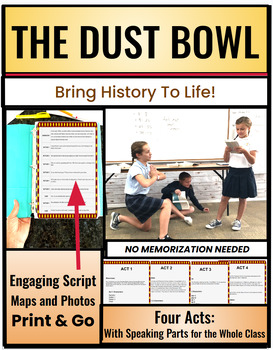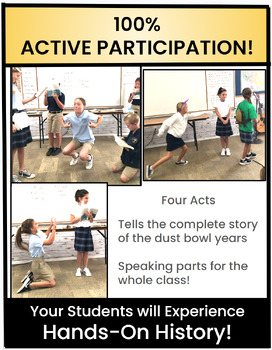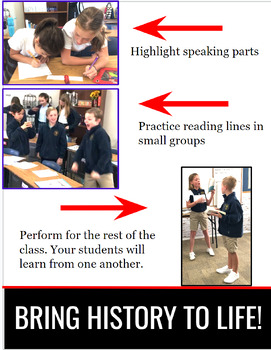The Dust Bowl - Great Plains, Drought, WWI, Depression, New Deal
- PDF
Description
“The Dust Bowl Years” A Reader’s Theater Script
Through vivid storytelling, your students will learn about the impact of farming, World War I, the great depression, and the consequences of the Dust Bowl. Your students will explore the challenges and triumphs of settlers in the Great Plains in the early 1900s.
Your students will gain insight into President Roosevelt's visionary New Deal and learn about strategies to restore the soil and prevent further erosion in the Great Plains.
Your students will gain empathy and understanding for the hardships faced by those who shaped our nation's heartland as they portray characters going through incredibly challenging times.
This resource is ready for you to print and hand out to your students. There are four acts in all, intended to be used by four small groups. The groups will work together reading and re-reading until their delivery is fluent and smooth and they're ready to present to the rest of the class. When all four acts are ready, the skit can be presented to other classes and/or PARENTS!
This historical reader’s theater script builds fluency through oral reading. The creative script captures students’ interest, so they'll be motivated to practice and perform.
If you’re looking for a highly motivating, engaging activity that even your most reluctant readers will love, this is the miracle you’ve been looking for!
Why Use Reader’s Theater?
· Reader’s Theater promotes reading fluency.
· It increases comprehension.
· It helps readers learn to read aloud with expression.
· It builds reading confidence.
· Reader’s Theater brings a story to life.
· It’s super motivating and makes learning FUN!
Students place their scripts in a sturdy three-ring binder and highlight their speaking parts. The wide left margin on student script pages allow for three-hole punching and any written notations, and each script includes a binder cover page.
Your stage can be anywhere—it can be at the front of your classroom or any open space. Allow students to rehearse together in small groups as you float around the room supervising.
While on stage, students hold their binders in one hand, leaving the other hand free for acting. Although students don’t memorize the script, they should know their part well enough to look up from their binders at the other characters often, about half the time.
Encourage characters to move around the stage and portray the action described in the story. If there are sounds in the story, they should be added where possible—explosions, wind, bees, roosters.
Encourage your students take ownership of the performance and then let the magic begin!




